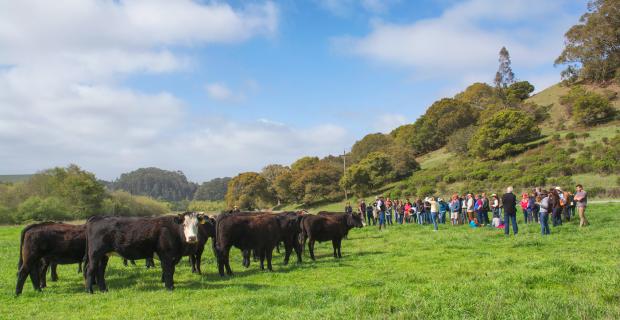Industrial Agriculture, Agroecology, and Climate Change

Today it is becoming more and more evident that the major problems of our time — energy, the environment, climate change, food security, financial security — cannot be understood in isolation.
They are systemic problems, which means that they are all interconnected and interdependent, and they require corresponding systemic solutions. To put it in another way, systemic problems have harmful consequences in several different areas, while systemic solutions solve problems in several of those areas. In this essay, I shall illustrate this important insight with the example of food systems and their causal connections with climate change.
Climate science is now an established scientific field, and its basic findings are well known. When sunlight warms the surface of the Earth, a large portion of the reflected thermal radiation is absorbed by greenhouse gases in the atmosphere. In the early history of the planet, this "greenhouse effect" created the protective envelope in which life was able to unfold, but since the Industrial Revolution, human activities have generated excessive greenhouse gas emissions. Thus, excessive amounts of heat have been trapped by the greenhouse effect, resulting in the global warming of the Earth's atmosphere beyond safe levels. Warmer air means that there is more energy and more moisture in the atmosphere, which can lead to a wide variety of consequences — floods, tornados, and hurricanes; but also droughts, heat waves, and wildfires. All of these consequences are threats to global food security.
Industrial agriculture
The links between industrial agriculture and climate change are twofold. On the one hand, industrially produced food systems are energy-intensive and fossil-fuel based, and thus contribute significantly to climate change. On the other hand, the crops grown in the genetically homogeneous monocultures that are typical of chemical farming are not resilient to the climate extremes that are becoming more frequent and more violent.
Industrial agriculture originated in the 1960s when petrochemical companies introduced new methods of intense chemical farming. For the farmers the immediate effect was a spectacular improvement in agricultural production, and the new era was hailed as the "Green Revolution." But a few decades later, the dark side of chemical agriculture became painfully evident.
It is well known today that the Green Revolution has helped neither farmers, nor the land, nor the consumers. The massive use of chemical fertilizers and pesticides changed the whole fabric of agriculture and farming, as the agrochemical industry persuaded farmers that they could make more money by planting large fields with a single highly profitable crop and by controlling weeds and pests with chemicals. This practice of single-crop monoculture entailed high risks of large acreages being destroyed by a single pest, and it also seriously affected the health of farm workers and people living in agricultural areas.
With the new chemicals, farming became mechanized and energy-intensive, favoring large corporate farmers with sufficient capital, and forcing most of the traditional single-family farmers to abandon their land. All over the world, large numbers of people left rural areas and joined the masses of urban unemployed as victims of the Green Revolution.
The long-term effects of excessive chemical farming have been disastrous for the health of the soil and for human health, for our social relations, and for the natural environment. As the same crops were planted and fertilized synthetically year after year, the balance of the ecological processes in the soil was disrupted; the amount of organic matter diminished, and with it the soil’s ability to retain moisture. The resulting changes in soil texture entailed a multitude of interrelated harmful consequences — loss of humus, dry and sterile soil, wind and water erosion, and so on.
The ecological imbalance caused by monocultures and excessive use of chemicals also resulted in enormous increases in pests and crop diseases, which farmers countered by spraying ever-larger doses of pesticides in vicious cycles of depletion and destruction. The hazards for human health increased accordingly as more and more toxic chemicals seeped through the soil, contaminated the water table, and showed up in our food.
In recent years, the disastrous effects of climate change have revealed another set of severe limitations of industrial agriculture. As Miguel Altieri and his colleagues at SOCLA (the Sociedad Cientifica Latinoamericana de Agroecologia) point out in a recent report, the Green Revolution was launched under the assumptions that abundant water and cheap energy from fossil fuels would always be available, and that the climate would be stable. None of these assumptions are valid today. The key ingredients of industrial agriculture — agrochemicals, as well as fuel-based mechanization and irrigation — are derived entirely from dwindling and ever more expensive fossil fuels; water tables are falling; and increasingly frequent and violent climate catastrophes wreak havoc with the genetically homogeneous monocultures that now cover 80 percent of global arable land. Moreover, the practices of industrial agriculture contribute about 25 to 30 percent to global greenhouse gas emissions, further accelerating climate change.
Our fossil-fuel based industrial agriculture contributes to greenhouse-gas emissions in several distinct ways: directly through the fuel burnt by agricultural machinery, during food processing, and by transporting the average ounce of food over a thousand miles "from the farm to the table"; indirectly in the manufacture of its synthetic inputs, e.g. of nitrogen fertilizer from nitrogen and natural gas; and finally by breaking down the organic matter in the soil into carbon dioxide (during large-scale tillage and as a consequence of excessive synthetic inputs), which is released into the atmosphere as a greenhouse gas. In addition, massive amounts of methane (a greenhouse gas many times more potent than CO2) are released during large-scale industrial cattle ranching.
The degrading of healthy organic soil by chemical fertilizers and pesticides increases the soil's vulnerability to drought by reducing its capacity to capture water and keep it available for crops. A further devastating effect of the over-fertilization that is typical of current chemical farming practices is the nutritional overload in our waterways, caused by runoffs of agricultural nitrates and phosphates, which lead to oxygen depletion in rivers and to so-called "dead zones" in the oceans, which are no longer inhabitable by most aquatic life.
From a systemic point of view, it is evident that a system of agriculture that is highly centralized, energy-intensive, excessively chemical, and totally dependent on fossil fuels; a system, moreover, that creates serious health hazards for farm workers and consumers, and is unable to cope with increasing climate disasters; cannot be sustained in the long run.
Agroecology: a sustainable alternative
Fortunately, there is a viable and sustainable alternative to industrial agriculture. It consists of a variety of agricultural techniques, often based on traditional practices, that have recently emerged around the world, and have greatly expanded over the last two decades. With these techniques, healthy organic food is grown in decentralized, community-oriented, energy-efficient, and sustainable ways. The ecologically oriented farming techniques are known variously as "organic farming," "permaculture," or "sustainable agriculture." In recent years, the term "agroecology" has increasingly been used as a unifying term, referring to both the scientific basis and the practice of an agriculture based on ecological principles.
When farmers grow crops organically, they use technologies based on ecological knowledge rather than chemistry or genetic engineering to increase yields, control pests, and build soil fertility. They plant a variety of crops, rotating them so that insects that are attracted to one crop will disappear with the next. They know that it is unwise to eradicate pests completely, because this would also eliminate the natural predators that keep pests in balance in a healthy ecosystem. Instead of chemical fertilizers, these farmers enrich their fields with manure and tilled-in crop residue, thus returning organic matter to the soil to reenter the biological cycle.
Organic farming is sustainable because it embodies ecological principles that have been tested by evolution for billions of years. Organic farmers know that a fertile soil is a living soil containing billions of living organisms in every cubic centimeter. It is a complex ecosystem in which the substances that are essential to life move in cycles from plants to animals, to manure, to soil bacteria, and back to plants. Solar energy is the natural fuel that drives these ecological cycles, and living organisms of all sizes are necessary to sustain the whole system and keep it in balance.
A key principle of agroecology is the diversification of farming systems. Mixtures of crop varieties are grown through intercropping (growing two or more crops in proximity), agroforestry (combining trees and shrubs with crops), and other techniques. Livestock is integrated into farms to support the ecosystems above the ground and in the soil. All these practices are labor-intensive and community-oriented, reducing poverty and social exclusion. In other words, agroecology is able to raise agricultural productivity in ways that are economically viable, environmentally benign, and socially uplifting.
Of critical importance for the future of agriculture is the observation that resilience to extreme climate events is closely linked to agricultural biodiversity, which is a key characteristic of agroecology. In recent years, several surveys conducted after major climate disasters — e.g., Hurricane Mitch in Central America (1998) and Hurricane Ike in Cuba (2008) — have shown that farms using agroecological practices suffered less damage than neighboring conventionally farmed monocultures. Other studies showed that diversified farming systems are able to adapt to and resist the effects of severe droughts, exhibiting greater yield stability and smaller decline of productivity than monocultures. When soil is farmed organically, moreover, its carbon content increases, and thus organic farming contributes to reducing the CO2 content of the atmosphere. In other words, agroecology not only is more resistant to global warming than industrial agriculture; it also helps stabilizing the climate, whereas industrial agriculture aggravates climate change.
In the longest-running side-by-side comparison of organic and chemical farming systems, the Rodale Institute found that 27 years of organic practices increased soil carbon by almost 30 percent, while the fossil-fuel based systems showed no significant increase during the same time period. Moreover, the Rodale trials showed that corn and soybean yields from the organic systems matched the yields from conventional systems in normal years and exceeded them by about 30 percent in drought years. The Rodale Institute report concludes that its soil data "show conclusively that...regenerative organic agricultural practices can be the most effective currently available strategy for mitigating CO2 emissions." The report estimates that globally organic agriculture could sequester nearly 40 percent of current CO2 emissions. In other words, instead of being a major cause of global warming, agriculture could be a major part of the solution.
There is now abundant evidence that agroecology is a sound ecological alternative to the chemical and genetic technologies of industrial agriculture. The first global assessment of sustainable agricultural practices in the developing world was conducted by agroecologist Jules Pretty and his colleagues in 2003. They documented clear increases in food production over some 29 million hectares, with nearly 9 million households benefiting from increased food diversity and security. A re-examination of the data in 2010, extending the survey to 37 million hectares, showed that the average crop yield increase was 79 percent.
In the last two decades, the realization of the contribution of peasant agriculture and of agroecology to food security have gained worldwide attention. Two major international reports (by IAASTD, the International Assessment of Agricultural Knowledge, Science, and Technology for Development, in 2009, and by the UN Human Rights Council in 2011) state that, in order to feed 9 billion people in 2050, we urgently need to adopt the most efficient farming systems, and they recommend a fundamental shift toward agroecology as a way to boost food production. Based on broad consultations with scientists and extensive literature reviews, both reports contend that small-scale farmers can double food production within 10 years in critical regions by using agroecological methods already available.
From a systems point of view, it is evident that agroecology is a systemic solution par excellence. If we changed from our chemical, large-scale industrial agriculture to organic, community-oriented, sustainable farming, this would contribute significantly to solving three of our biggest problems. It would greatly reduce our energy dependence, because we are now using one fifth of our fossil fuels to grow and process food. The healthy, organically grown food would have a huge positive effect on public health, because many chronic diseases — heart disease, stroke, diabetes, and so on — are linked to our diet. And finally, organic farming would contribute significantly to fighting climate change by drawing CO2 from the atmosphere and locking it up in organic matter.
In recent years, the Rodale Institute in Pennsylvania, Miguel Altieri's SOCLA in Latin America, and similar organizations around the world have trained thousands of farmers, proving that the shift from industrial agriculture to agroecological practices is not only urgently needed, but is also practical and can be achieved without new technologies or expensive investments. What we need now to scale up these practices from thousands of successful local and regional projects to the global level is political will and leadership.
Suggested further reading
Fritjof Capra and Pier Luigi Luisi, The Systems View of Life: A Unifying Vision (Cambridge University Press, 2014); Chapter 18 ("Systemic Solutions").
Tim J. LaSalle and Paul Hepperly, "Regenerative Organic Farming: A Solution to Global Warming," Rodale Institute Report, 2008.
M. Altieri, C. Nicholls, F. Funes, and other members of SOCLA, "The Scaling-up of Agroecology: Spreading the Hope for Food Sovereignty and Resiliency," May 2012.
J.J. Pretty, J., J. Morrison and R. Hine, "Agriculture, Ecosystems and Environment," 2003.




